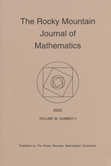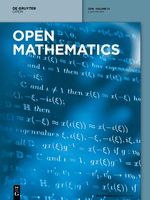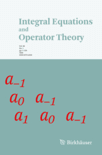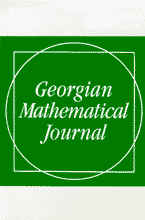
JOURNAL OF APPROXIMATION THEORY
Scope & Guideline
Unveiling New Horizons in Mathematical Sciences
Introduction
Aims and Scopes
- Polynomial Approximation:
This area investigates the properties and applications of polynomial approximations, including Bernstein-type inequalities, Markov inequalities, and convergence properties in different spaces. - Functional Analysis and Spaces:
The journal explores approximation in various functional spaces, such as Sobolev spaces, Banach spaces, and Bergman spaces, emphasizing their geometric and analytical properties. - Numerical Methods and Algorithms:
Research in this scope focuses on the development and analysis of algorithms for approximation, including neural networks, cubature formulas, and approximation error bounds. - Orthogonal Polynomials:
This includes studies on the properties, applications, and asymptotic behaviors of orthogonal polynomials, with a focus on their role in approximation theory. - Scattered Data and Function Recovery:
The journal publishes works on methods for recovering functions from scattered data, including interpolation techniques and the analysis of convergence rates. - Randomized Approximations:
This area covers the use of probabilistic methods in approximation, including randomized algorithms and their efficiency in approximation tasks.
Trending and Emerging
- High-Dimensional Approximation Techniques:
Recent articles emphasize the challenges and methodologies for approximating functions in high-dimensional spaces, reflecting the growing importance of this area in applications such as machine learning and data science. - Neural Networks in Approximation:
There is an increasing trend towards exploring the use of neural networks for approximation tasks, including error analysis and convergence guarantees, indicating a fusion of traditional approximation theory with modern computational techniques. - Multivariate and Complex Approximations:
The journal has seen a rise in publications focusing on multivariate approximation methods, particularly those that utilize complex variables or higher-dimensional function spaces. - Asymptotic Analysis and Convergence Rates:
Emerging studies are placing greater emphasis on asymptotic behaviors and convergence rates of various approximation methods, which are critical for understanding their efficiency and applicability. - Approximation in Non-standard Spaces:
Research is increasingly addressing approximation in non-standard spaces, such as Triebel-Lizorkin and Sobolev spaces with generalized smoothness, showcasing a trend towards more sophisticated mathematical frameworks.
Declining or Waning
- Historical Studies of Approximation:
Recent publications show a decline in historical analyses of approximation methods, such as studies on Chebyshev polynomials from historical contexts, indicating a shift toward more contemporary applications. - Low-dimensional Polynomial Approximations:
There appears to be less emphasis on approximations in low-dimensional spaces, with more research directed towards high-dimensional and complex approximations. - Traditional Inequalities:
Classical inequalities related to approximation, such as the Landau-Kolmogorov inequalities, have seen reduced frequency in publications, suggesting a potential shift towards newer inequalities or more complex settings.
Similar Journals

ROCKY MOUNTAIN JOURNAL OF MATHEMATICS
Fostering Collaboration in Diverse Mathematical FieldsROCKY MOUNTAIN JOURNAL OF MATHEMATICS, published by the Rocky Mountain Math Consortium, serves as a critical platform for researchers and practitioners in the field of mathematics since its inception in 1971. With a notable presence in the academic community, this journal covers a broad spectrum of mathematical disciplines, positioning itself in the Q2 category for Mathematics (miscellaneous) as of 2023. Despite being a subscription-based journal, it is recognized for its rigorous peer-review process and contributions to theoretical and applied mathematics, helping to advance knowledge and foster collaboration among mathematicians. The journal's ISSN number is 0035-7596 and its E-ISSN is 1945-3795, reflecting its commitment to accessibility and dissemination of high-quality research. Based in Tempe, Arizona, at Arizona State University, the journal continues to play an important role in shaping contemporary mathematical discourse through well-researched articles and innovative studies, aiming to bridge gaps between various mathematical subfields and engage a diverse audience, including students and established researchers alike.

Algorithms
Advancing the Frontiers of Computational Insight.Algorithms is a prestigious and innovative journal published by MDPI, focusing on the rapidly evolving fields of computational mathematics, numerical analysis, and theoretical computer science. Launched in 2008, this open access journal seeks to foster collaboration and knowledge sharing among researchers, professionals, and students by providing a platform for the dissemination of high-quality research articles, reviews, and notes. With its operational base in Basel, Switzerland, Algorithms has steadily established itself in the academic community, achieving commendable rankings such as Q2 in Computational Mathematics and Numerical Analysis, as well as Q3 in Computational Theory and Mathematics and Theoretical Computer Science as of 2023. Furthermore, the journal boasts impressive Scopus rankings, placing it within the top 20% in several categories, underscoring its relevance and influence in the field. As an open access journal, Algorithms ensures that its content is accessible to all, promoting the advancement of algorithmic research and fostering critical discussions that may shape the future of the discipline.

ELECTRONIC TRANSACTIONS ON NUMERICAL ANALYSIS
Empowering Scholars with Cutting-Edge Research in AnalysisELECTRONIC TRANSACTIONS ON NUMERICAL ANALYSIS, published by Kent State University, is an esteemed journal dedicated to the field of numerical analysis and applied mathematics. With its ISSN 1068-9613, this journal serves as a vital resource for researchers and practitioners engaged in the advancement of numerical techniques and their applications, offering insights that bridge theoretical foundations and practical implementations. The journal, which displays robust visibility in the academic community, currently holds a commendable rank of Q2 in both the Analysis and Applied Mathematics categories as of 2023, illustrating its significance within the research landscape. Though subscription-based access options are not specified, the journal consistently endeavors to disseminate cutting-edge research findings to its audience, enriching the scholarly dialogue in the mathematical sciences. Spanning from 1996 to 2024, it has fostered a platform for dynamic exchange among thinkers across the globe, making it an essential publication for those seeking to influence and innovate within this critical area of study.

Open Mathematics
Fostering Collaboration Through Open Mathematical DiscourseOpen Mathematics, published by DE GRUYTER POLAND SP Z O O, is a prominent peer-reviewed journal that has been a vital platform for disseminating innovative research in the field of mathematics since its inception in 2015. With an impressive impact factor reflected by its Q2 ranking in the miscellaneous mathematics category and a commendable Scopus rank of #91 out of 399, it positions itself as a significant contributor to the mathematical community. This open access journal, headquartered in Poland, welcomes submissions that tackle diverse mathematical theories, applications, and methodologies, fostering knowledge exchange among researchers, professionals, and students globally. Since its launch, Open Mathematics has focused on bridging the gap between theoretical advancement and practical applications, making it an essential resource for anyone seeking to stay at the forefront of mathematical research and innovation. The journal offers easy online access, enhancing the visibility and impact of the valuable work published within its pages.

Studia Universitatis Babes-Bolyai Mathematica
Fostering Scholarly Dialogue in MathematicsStudia Universitatis Babes-Bolyai Mathematica is a prestigious journal published by UNIV BABES-BOLYAI in Romania, dedicated to advancing the field of mathematics and its diverse applications. With an ISSN of 0252-1938 and E-ISSN 2065-961X, this journal has carved out its niche in the Q3 category of miscellaneous mathematics as of 2023, ranking 315 out of 399 in the Scopus Mathematics General category, reflecting its commitment to quality and relevance in mathematical research. Covering a wide range of mathematical topics, it seeks to foster scholarly dialogue and innovation among researchers, practitioners, and students. Although it operates under a traditional access model, the journal remains a vital resource for the mathematical community, inviting submissions that contribute to theoretical advancements and practical applications. Established in 2016, Studia Universitatis Babes-Bolyai Mathematica is poised to remain a central platform for groundbreaking research through 2024 and beyond, making it an essential addition to the libraries of those engaged in mathematical study and discourse.

Eurasian Mathematical Journal
Innovating Insights, Inspiring Applications.Welcome to the Eurasian Mathematical Journal, a prominent platform dedicated to advancing the field of mathematics, particularly in its miscellaneous applications. Published by the esteemed L N Gumilyov Eurasian National University in Kazakhstan, this journal has been serving the academic community since 2014. With an ISSN of 2077-9879, it has successfully carved its niche within the mathematical landscape, presently ranked Q2 and placing in the 64th percentile among general mathematics publications in Scopus. The journal aims to foster scholarly exchange through high-quality research articles, reviews, and theoretical advancements that enhance understanding and application of mathematical concepts. By prioritizing open accessibility and a rigorous peer-review process, the Eurasian Mathematical Journal contributes significantly to both theoretical exploration and practical innovation, making it an essential resource for researchers, professionals, and students alike.

INTEGRAL EQUATIONS AND OPERATOR THEORY
Innovative insights into algebra and number theory.INTEGRAL EQUATIONS AND OPERATOR THEORY, published by SPRINGER BASEL AG, stands at the forefront of research in the fields of algebra, number theory, and analysis, with an esteemed categorization of Q2 in both disciplines as of 2023. With its ISSN 0378-620X and E-ISSN 1420-8989, this journal not only maintains a rigorous standard for scholarly contributions but also offers a vital platform for discourse on theoretical and applied aspects of integral equations and operator theory. Established in 1978, it has nurtured academic growth and innovation, with contributions continuing up to 2024. The journal holds respectable Scopus rankings, placed 43rd out of 119 in Algebra and Number Theory, and 110th out of 193 in Analysis, establishing its relevance and impact within the mathematical community. Researchers, professionals, and students alike will find INTEGRAL EQUATIONS AND OPERATOR THEORY to be an invaluable resource for advancing knowledge, fostering collaboration, and inspiring future studies within these critical areas of mathematics.

Jaen Journal on Approximation
Innovating Insights in Approximation and AnalysisJaen Journal on Approximation (ISSN: 1889-3066; E-ISSN: 1989-7251) is a distinguished academic platform published by UNIV JAEN, ESCUELA UNIV MAGISTERIO SAGRADA FAMILIA, catering to the field of Mathematics with a specialized focus on approximation theory, numerical analysis, and their applications. Established in Spain, this journal has been a critical resource for researchers and practitioners since its inception, with active publication years spanning from 2009 to 2019 and a recent resurgence from 2021 to 2022. Although currently categorized in Q4 among Analysis and Numerical Analysis disciplines, it provides invaluable insights and fosters discussion on topics pertinent to contemporary mathematical research. The journal is accessible without Open Access options, affirming its commitment to preserving the academic integrity of the research it disseminates. As researchers seek to navigate the complexities of numerical methods and approximation strategies, the Jaen Journal on Approximation remains an essential resource, inviting contributions that enhance understanding and innovation in the mathematical sciences.

Georgian Mathematical Journal
Elevating scholarly communication in the realm of mathematics.Georgian Mathematical Journal, published by Walter de Gruyter GmbH, is a prestigious academic journal dedicated to the field of mathematics, particularly in its multifaceted applications and theoretical explorations. With an ISSN of 1072-947X and an E-ISSN of 1572-9176, this journal is indexed within notable databases and holds a strong position as evidenced by its Q2 ranking in the Mathematics (miscellaneous) category as of 2023 and a ranking of #140 out of 399 in the general mathematics Scopus category, placing it in the 65th percentile for research visibility. Since its inception in 1994, the journal has continued to evolve, aiming to foster innovative research and scholarly communication among mathematicians worldwide. Although it does not offer Open Access, the journal’s commitment to quality and rigor ensures that published works are of high relevance, appealing to researchers, educators, and students who are dedicated to advancing mathematical knowledge across diverse domains.

JOURNAL OF MATHEMATICAL ANALYSIS AND APPLICATIONS
Connecting Researchers with Cutting-Edge FindingsThe JOURNAL OF MATHEMATICAL ANALYSIS AND APPLICATIONS, published by Academic Press Inc Elsevier Science, represents a leading platform in the fields of mathematical analysis and applied mathematics. With its esteemed Q1 ranking in Analysis and Q2 in Applied Mathematics, this journal plays a vital role in disseminating high-quality research that addresses complex mathematical problems and their applications in various scientific domains. Covering a broad spectrum of topics, the journal has been a cornerstone of mathematical scholarship since its inception in 1960 and continues to thrive with contributions from prominent researchers across the globe, expected to extend through 2025. The journal is indexed in Scopus, currently ranking #60 out of 193 in Mathematics Analysis and #281 out of 635 in Applied Mathematics, reflecting its significant impact in the academic community. Although it does not offer open access options, researchers and professionals are encouraged to subscribe to access cutting-edge findings and insights. As an essential resource, the journal fosters the advancement of mathematical theories and their practical applications, making it indispensable for mathematicians, academics, and industry professionals alike.